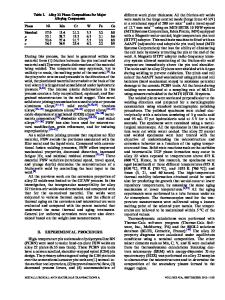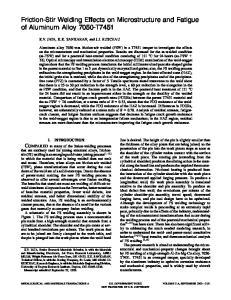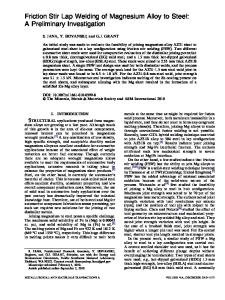Friction Stir Welding of Stainless Steel to Al Alloy: Effect of Thermal Condition on Weld Nugget Microstructure
- PDF / 741,633 Bytes
- 10 Pages / 593.972 x 792 pts Page_size
- 49 Downloads / 360 Views
INTRODUCTION
ALUMINUM and stainless steel are highly incompatible with each other when joined together owing to the difference in melting point, limited solid solubility, formation of brittle intermetallics, and the wide difference in thermal properties. Independently light nonferrous aluminum and its derivatives possess a substantial strength-toweight ratio, adequate heat transfer capability, and satisfactory formability. On the other hand, unique characteristics of stainless steel are good corrosion resistance, strength, and toughness. The combination of two alloys is promising to execute the complex function in aerospace and automotive industries for superior fuel efficiency, increased fly range, and better air pollution control. Fusion welding of them promotes a heterogeneous cast structure, a huge quantity of brittle intermetallic phases, and excessive stress. Therefore, to obtain a hybrid structure, a suitable joining technique is required to provide reliability and reproducibility. In this respect, major attempts were made in regard to friction welding, ultrasonic joining, explosive welding, and electric discharge bonding.[1–4] In friction welding, with the increase in friction time, the joint strength was increased, reached maximum, and then dropped.[5] It was reported that the friction-welded interface of aluminum and austenitic stainless steel contained Fe2Al5, FeAl3, Fe3Al, and FeAl brittle phases.[6–8] Friction welding of aluminum alloy–stainless steel illustrated the presence of an alternate crystalline-amorphous stacked layer at the interface.[9] Friction welding has its limitation, as the M. GHOSH and M.M. HUSAIN, Junior Scientist, Materials Science and Technology Division, and R.K. GUPTA, Scientist, Engineering Division, are with the CSIR—National Metallurgical Laboratory, Jamshedpur - 831007, India. Contact e-mail: [email protected] Manuscript submitted April 27, 2013. Article published online November 1, 2013 854—VOLUME 45A, FEBRUARY 2014
technique can be applied only for tubular parts. Similarly, ultrasonic welding is limited for joining very thin sheets. A solid-state technique such as friction stir welding (FSW)/friction stir spot welding (FSSW) offers novelty over others for joining dissimilar materials, because it can be used for components of any shape and materials with a wide difference in physicochemical properties. Uzun et al.[10] attempted FSW between 6013-T4 Al and X5CrNi18-10 stainless steel. They discussed the microstructure at different regions, microhardness distribution, fatigue property, and interdiffusion of chemical species. FSW of AA6056 aluminum alloy and 304SS was investigated by Lee et al.,[11] and interfacial characteristics were depicted by transmission electron microscopy. A comprehensive illustration of the interface microstructure was provided by Ogura et al.[12] on FSW of the A3003-H112 Al alloy and commercial SUS304 plate using a 900 rpm toll rotational rate and 300 mm min–1 tool traversing speed. They observed the formation of a nanometer scale amorphous interfacial layer
Data Loading...











